Lyons W.C. (ed.). Standard handbook of petroleum and natural gas engineering.2001- Volume 1
Подождите немного. Документ загружается.


Mud Pumps
645
APa
=
pressure loss in annulus in psi
AP,,
=
pressure drop through bit nozzles in psi
Table
4-42
shows the jet velocity. Table
443
shows the diameters and areas
of
various nozzle sizes.
The required pump hydraulic horsepower (PHHP) can be calculated as
PHHP
=
HHPcirc
+
HHPbit
(4-37)
where HHPci,,
=
total HHP loss due to pressure losses in the circulating system
HHPbit
=
hydraulic horsepower required at the bit
The general hydraulic horsepower is
Q
LIP
HHP
=
-
1714
(4-38)
where
Q
=
flow rate in gal/min
AP
=
pressure difference in psi
The minimum bit HHP
is
shown in Figure
4-104.
The maximum useful bit
HHP is shown in Figure
4-105
and Figure
4-106
[18].
Useful Formulas
Theoretical output
Q,
(gal/min) for a double action duplex pump
is
Q,
=
O.O13GNS(
0;
-
$)
(4-39)
where
N
=
strokes per minute
S
=
stroke length in in.
D,
=
liner diameter in m
d
=
piston rod diameter in in.
Theoretical output
Q,
(gal/min) for a single action triplex pump
is
(2,
=
0.0102
NS
0:
The volumetric efficiency
q,
for duplex pumps or triplex pumps
is
(4-40)
q
=a
Q
"
Q,
(441)
where
Q,
=
actual volumetric flow rate in gal
Q,
and pump working pressure PWP is
Input engine power IHP (hp) required for
a
given pump theoretical output
(text
continued
on
page
650)

646
Drilling and Well Completions
Table
4-42
Jet Velocity
[Y
51
...
,
...
,
..............
...I
..,
......
..4-...j
..
.,.I
...
...
i
...
I
...
:
..
!
...
!
...
I
...
1
...
....
I.../.
1..
.,_!..j.../...
.........
201
173
149
-
-
__
-
..
212
I
I,,
I
1%
I
..
I
........
),I
...
_..:
...
;
...
I
...
i
so
103
107
112
116
120
121
1
.'S
131
!
37
.../
.........
...
...
i
'
,
..'
i
...
I
....
..:..I
..
...;
...
I
...
..
,I...
4
1011
...
I:':[
...
...
..
...
..
...
...
...
~~
...
-.
...
-
...
...
...
...
...
-~
-
...
...
...
...
...
...
~
...
--
-
I.
-
...
__
...
...
...
__
...
...
...
...
...
..
...
...
..
...
...
101
102
103
106
108
107
...
.-..
_.
im
...
110
Ill
113
114
115
117
__
ita
120
121
122
121
1
2i
1m
im
_.
la
-
..
-.
129
-
-
132
133
I34
I34
117
I=
140
-
-
-
__
-
-
__
-
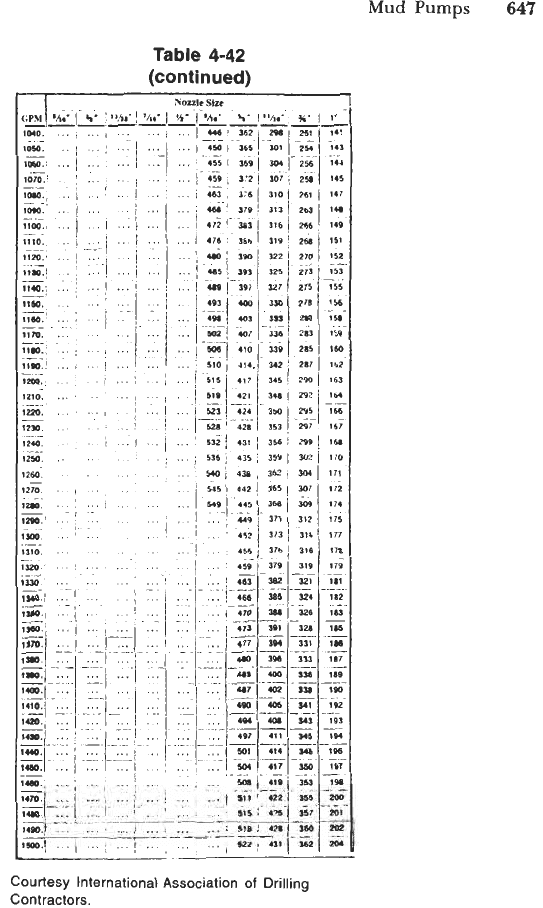
Mud
Pumps
647
Table
4-42
(continued)
I
NO2
imo.
...
1050.
..
1060.1
...
.
.-
-
.-
10M.i
..
-
1010.;
...
__
.
lo*).
...
llrn.,
...
~
-.
lIlO.,
...
1120.:
...
iim.1 ...
-
..
1140.1
...
_I
-
...
GK!
.::
iim.
...
1110.1
...
FmYl
.I.
lam.: ...
1210.:
...
,
..
-
-
.....
__
...
-
.-
1220.
.......
-
630;.
......
1210.
...I
..
.-
1250.
....
1260.
.....
-
1270.
...
I
...
~.
*.
!
,,,y
I
.h,'
._I
...
'."
I
"'
."
'..
I
"'
I,
...
,
......
-.-.-
.
'
-1
".:
:':I
,.
_I
..,
-1
...I
::.
;.;-I
:::
1
..;
......
,
...
,
.
~~
...
j
...
1
...
...
I...
...
I
...I
...
.
I
..
I
...
.--I
:f:
......
..:I
. .
~
-.
..
..
......
I
..
...
,
...
...
j
':'
.- ~
_''
.......
._.I
...
.....
5-
-
...
...
...
...
...
...
...
...
...
...
...
...
...
...
...
...
...
...
...
..
...
...
...
...
...
...
______r_
yD./
...I
...I
...
I
......
...
i
5221
81,
Courtesy International Association
of
Drilling
Contractors.
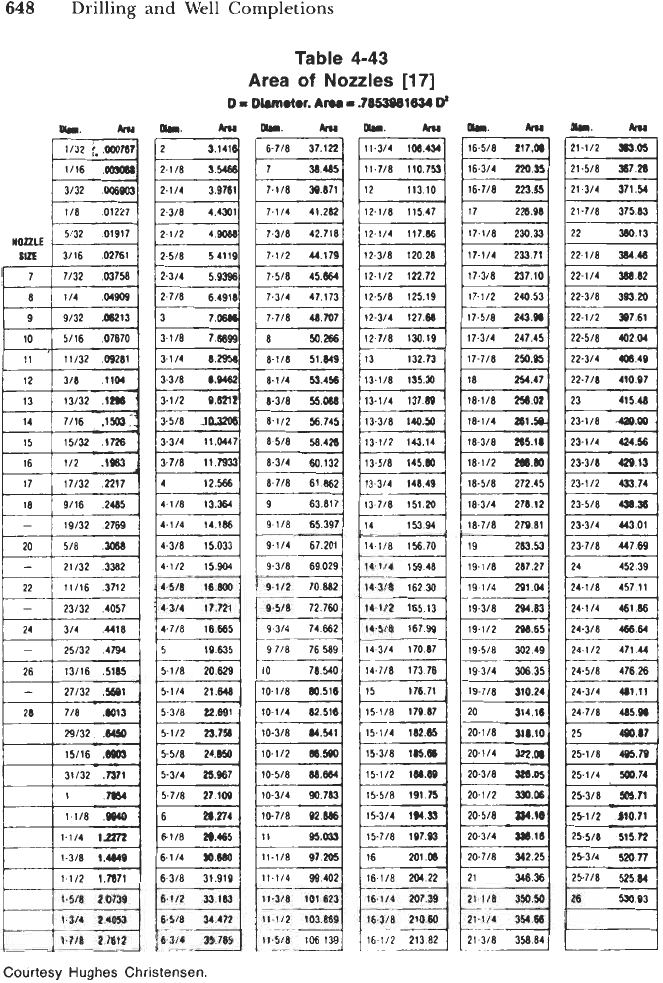
1."y
SZ'Z#
8/1-02
01
ncf,
VIE-02
0)'-
8/5-02
11'1W
VIE-VZ
92'9L*
BIS-VZ
VYLLV
2/1-V2
I1
LSV
8/1+2
I
(oil'
WE
I
21
I
I
EI'OOF
22
I
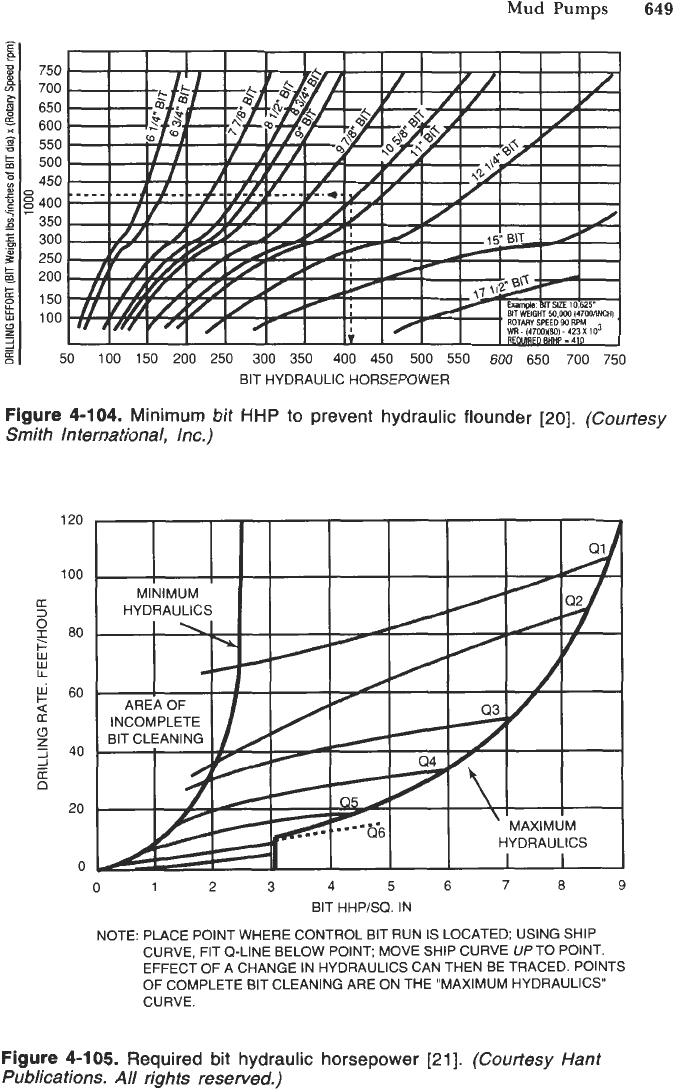
DRILLING
RATE.
FEETlHOUR
A
2
N
0
0
0
00
W
0
m
0
P
0
N
zo
m
s
(J)
3
DRILLING
EFFORT
(BIT
Weight
Ibshches
of
BIT
dia)
x
(Rotary
Speed
rpm)
35
1000
4'c
--
NUNWWP
PmVIma.4.4
3-
oul
omoulo
ulovlo,ovl
(D
00000000000000
y
3.
0
3N
CrW
0
0"
g%
i!
BP
5
K8
0
N
L
rc
IP
I
+"
DO
C
m
IO
YTJ
So
=
-.
mo
Om
0
0
m
K
3
Q
?
m
=
8
0 0
-
rug
L_
0.4
0
0.4
,
s
%
0 0
-
0
k
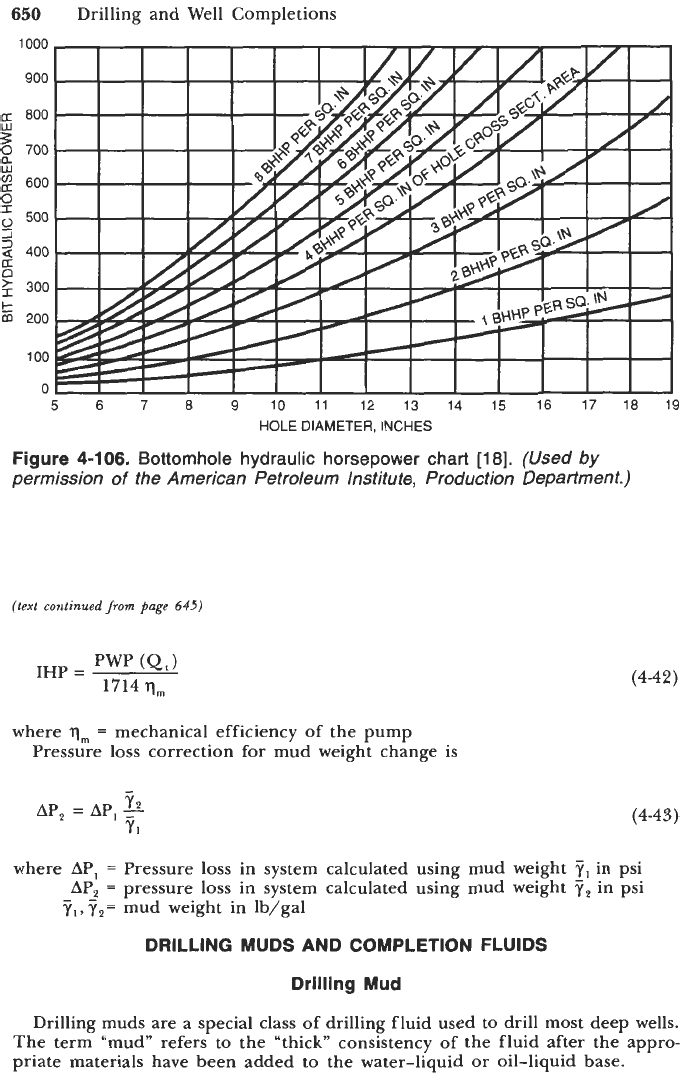
650
Drilling and Well Completions
Figure
4-106.
Bottomhole hydraulic horsepower chart
[18].
(Used
by
permission
of
the American Petroleum Institute, Production Department.)
(text
continued
from
page
645)
(4-42)
where
q,
=
mechanical efficiency of the pump
Pressure loss correction for mud weight change is
-
Y
Y1
AP,
=
APl
=?-
(4-43)
where AP,
=
Pressure
loss
in system calculated using mud weight
7,
in psi
AP,
=
pressure loss in system calculated using mud weight
7,
in psi
mud weight in lb/gal
DRILLING MUDS AND COMPLETION FLUIDS
Drilling Mud
Drilling muds are a special class of drilling fluid used to drill most deep wells.
The term “mud” refers to the “thick” consistency of the fluid after the appro-
priate materials have been added to the water-liquid
or
oil-liquid base.
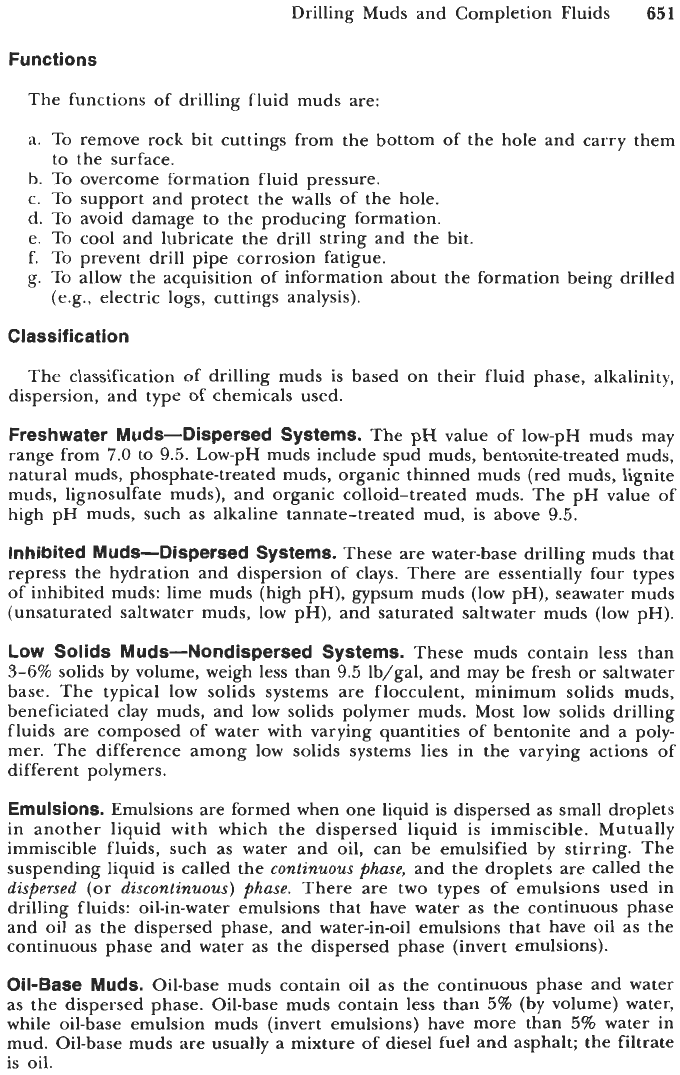
Drilling Muds and Completion Fluids
651
Functions
The functions of drilling fluid muds are:
a.
To
remove rock bit cuttings from the bottom of the hole and carry them
b. To overcome formation fluid pressure.
c. To support and protect the walls of the hole.
d. To avoid damage to the producing formation.
e. To cool and lubricate the drill string and the bit.
f.
To
prevent drill pipe corrosion fatigue.
g.
To allow the acquisition of information about the formation being drilled
(e.g., electric logs, cuttings analysis).
to
the surface.
Classification
The classification
of
drilling muds is based on their fluid phase, alkalinity,
dispersion, and type of chemicals used.
Freshwater Muds-Dispersed Systems.
The pH value of low-pH muds may
range from
7.0
to 9.5. Low-pH muds include spud muds, bentonite-treated muds,
natural muds, phosphate-treated muds, organic thinned muds (red muds, lignite
muds, lignosulfate muds), and organic colloid-treated muds. The pH value of
high pH muds, such as alkaline tannate-treated mud, is above 9.5.
Inhibited Muds-Dispersed Systems.
These are water-base drilling muds that
repress the hydration and dispersion of clays. There are essentially four types
of inhibited muds: lime muds (high pH), gypsum muds (low pH), seawater muds
(unsaturated saltwater muds, low pH), and saturated saltwater muds (low pH).
Low Solids Muds-Nondispersed Systems.
These muds contain less than
3-6%
solids by volume, weigh less than
9.5
lb/gal, and may be fresh or saltwater
base. The typical low solids systems are flocculent, minimum solids muds,
beneficiated clay muds, and low solids polymer muds. Most low solids drilling
fluids are composed of water with varying quantities of bentonite and a poly-
mer. The difference among low solids systems lies in the varying actions of
different polymers.
Emulsions.
Emulsions are formed when one liquid is dispersed as small droplets
in another liquid with which the dispersed liquid is immiscible. Mutually
immiscible fluids, such as water and oil, can be emulsified by stirring. The
suspending liquid is called the
continuous phase,
and the droplets are called the
dispersed
(or
discontinuous) phase.
There are two types of emulsions used in
drilling fluids: oil-in-water emulsions that have water as the continuous phase
and
oil
as the dispersed phase, and water-in-oil emulsions that have oil as the
continuous phase and water as the dispersed phase (invert emulsions).
Oil-Base Muds.
Oil-base muds contain oil as the continuous phase and water
as the dispersed phase. Oil-base muds contain less than
5%
(by volume) water,
while oil-base emulsion muds (invert emulsions) have more than 5% water in
mud. Oil-base muds are usually a mixture
of
diesel fuel and asphalt; the filtrate
is oil.
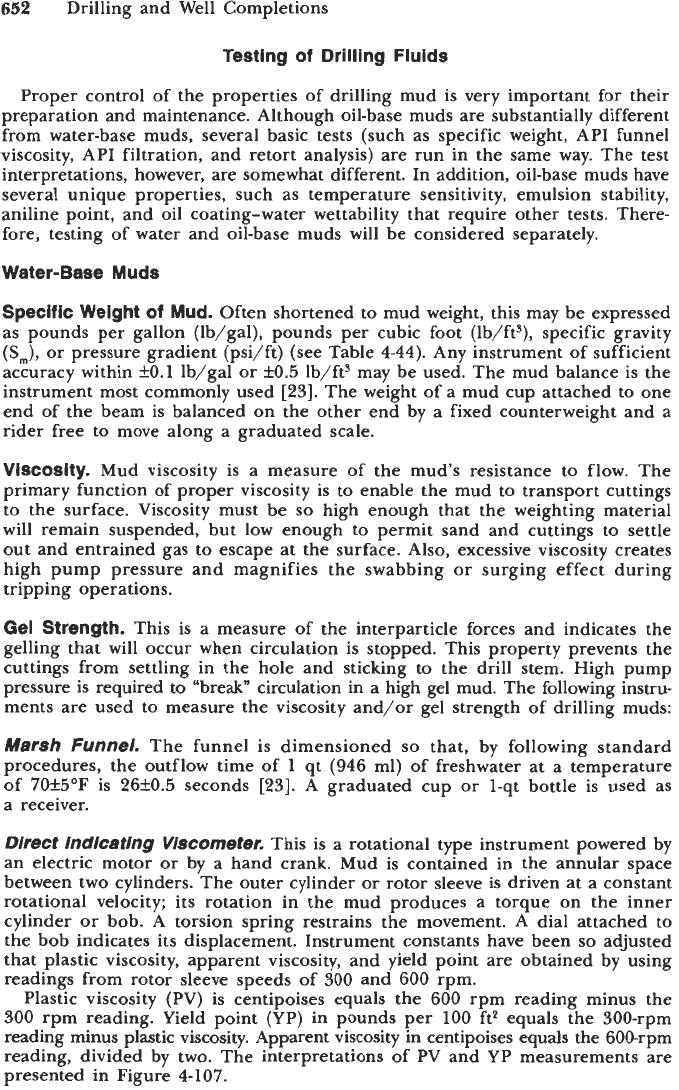
652
Drilling and Well Completions
Testing
of
Drilling Fluids
Proper control of the properties of drilling mud is very important for their
preparation and maintenance. Although oil-base muds are substantially different
from water-base muds, several basic tests (such as specific weight, API funnel
viscosity, API filtration, and retort analysis) are run in the same way. The test
interpretations, however, are somewhat different. In addition, oil-base muds have
several unique properties, such as temperature sensitivity, emulsion stability,
aniline point, and oil coating-water wettability that require other tests. There-
fore, testing
of
water and oil-base muds will be considered separately.
Water-Base
Muds
Specific Weight
of
Mud.
Often shortened to mud weight, this may be expressed
as pounds per gallon (lb/gal), pounds per cubic foot (lb/ft3), specific gravity
(S,,,),
or
pressure gradient (psi/ft) (see Table 4-44). Any instrument of sufficient
accuracy within
fO.l
lb/gal
or
k0.5
lb/ft3 may be used. The mud balance is the
instrument most commonly used [23]. The weight of a mud cup attached to one
end of the beam is balanced on the other end by a fixed counterweight and a
rider free to move along a graduated scale.
Viscosity.
Mud viscosity is a measure of the mud’s resistance to flow. The
primary function of proper viscosity is to enable the mud to transport cuttings
to the surface. Viscosity must be
so
high enough that the weighting material
will remain suspended, but low enough to permit sand and cuttings to settle
out and entrained gas to escape at the surface. Also, excessive viscosity creates
high pump pressure and magnifies the swabbing
or
surging effect during
tripping operations.
Gel
Strength.
This is a measure of the interparticle forces and indicates the
gelling that will occur when circulation is stopped. This property prevents the
cuttings from settling in the hole and sticking to the drill stem. High pump
pressure is required to “break” circulation in a high gel mud. The following instru-
ments are used to measure the viscosity and/or gel strength of drilling muds:
Marsh
Funnel.
The funnel is dimensioned
so
that, by following standard
procedures, the outflow time of
1
qt (946 ml) of freshwater at a temperature
of 70f5”F is 26f0.5 seconds [23]. A graduated cup
or
1-qt bottle is used as
a receiver.
Direct /ndicating Viscometer.
This is a rotational type instrument powered by
an electric motor
or
by a hand crank. Mud is contained in the annular space
between two cylinders. The outer cylinder or rotor sleeve is driven at a constant
rotational velocity; its rotation in the mud produces a torque on the inner
cylinder
or
bob.
A
torsion spring restrains the movement. A dial attached to
the bob indicates its displacement. Instrument constants have been
so
adjusted
that plastic viscosity, apparent viscosity, and yield point are obtained by using
readings from rotor sleeve speeds of 300 and 600 rpm.
Plastic viscosity (PV) is centipoises equals the 600 rpm reading minus the
300 rpm reading. Yield point (YP) in pounds per
100
ft2 equals the 300-rpm
reading minus plastic viscosity. Apparent viscosity in centipoises equals the 600-rpm
reading, divided by two. The interpretations of PV and YP measurements are
presented in Figure 4-107.
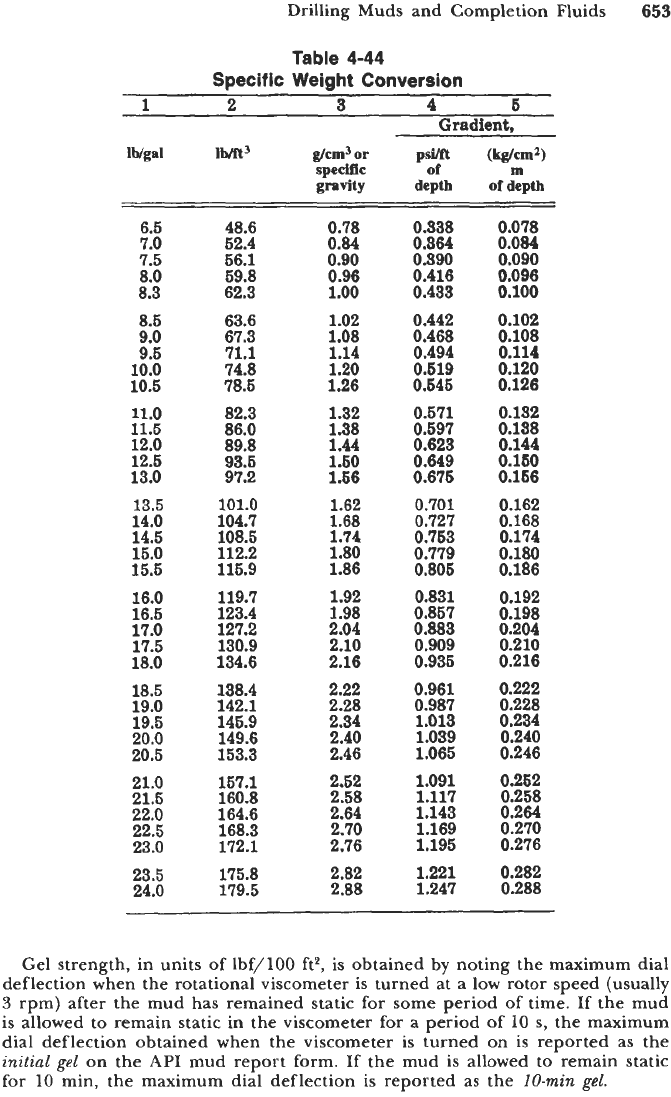
Drilling Muds and Completion Fluids
653
Table
4-44
Specific Weight Conversion
1 2 3
4
5
Gradient,
1Wgd
lbm3
glem30r
p~vn
(t@d)
spodfic
of
m
gravity
depth
ofdepth
6.5
7.0
7.5
8.0
8.3
8.6
9.0
9.5
10.0
10.5
11.0
11.5
12.0
12.5
13.0
13.5
14.0
14.5
15.0
15.5
16.0
16.5
17.0
17.5
18.0
18.5
19.0
19.5
20.0
20.5
21.0
21.5
22.0
22.5
23.0
23.5
24.0
48.6
52.4
66.1
59.8
62.3
63.6
67.3
71.1
74.8
78.5
82.3
86.0
89.8
93.6
97.2
101.0
104.7
108.5
112.2
116.9
119.7
123.4
127.2
130.9
134.6
138.4
142.1
145.9
149.6
153.3
157.1
160.8
164.6
168.3
172.1
175.8
179.5
0.78
0.84
0.90
0.96
1.00
1.02
1.08
1.14
1.20
1.26
1.32
1.38
1.44
1.60
1.66
1.62
1.68
1.74
1.80
1.86
1.92
1.98
2.04
2.10
2.16
2.22
2.28
2.34
2.40
2.46
2.52
2.58
2.64
2.70
2.76
2.82
2.88
0.338
0.364
0.390
0.416
0.433
0.442
0.468
0.494
0.619
0.546
0.671
0.597
0.623
0.649
0.675
0.701
0.727
0.763
0.779
0.806
0.831
0.857
0.883
0.909
0.936
0.961
0.987
1.013
1.039
1.065
1.091
1.117
1.143
1.169
1.195
1.221
1.247
0.078
0.084
0.090
0.096
0.100
0.102
0.108
0.114
0.120
0.126
0.132
0.138
0.144
0.150
0.166
0.162
0.168
0.174
0.180
0.186
0.192
0.198
0.204
0.210
0.216
0.222
0.228
0.234
0.240
0.246
0.262
0.258
0.264
0.270
0.276
0.282
0.288
Gel strength, in units of lbf/100 fts, is obtained
by
noting the maximum dial
deflection when the rotational viscometer is turned at a low rotor speed (usually
3
rpm) after the mud has remained static for some period of time.
If
the mud
is allowed to remain static in the viscometer for a period
of
10
s,
the maximum
dial deflection obtained when the viscometer is turned on is reported as the
initial
gel
on the
API
mud report form. If the mud is allowed
to
remain static
for
10
min, the maximum dial deflection
is
reported as the
IO-min
gel.
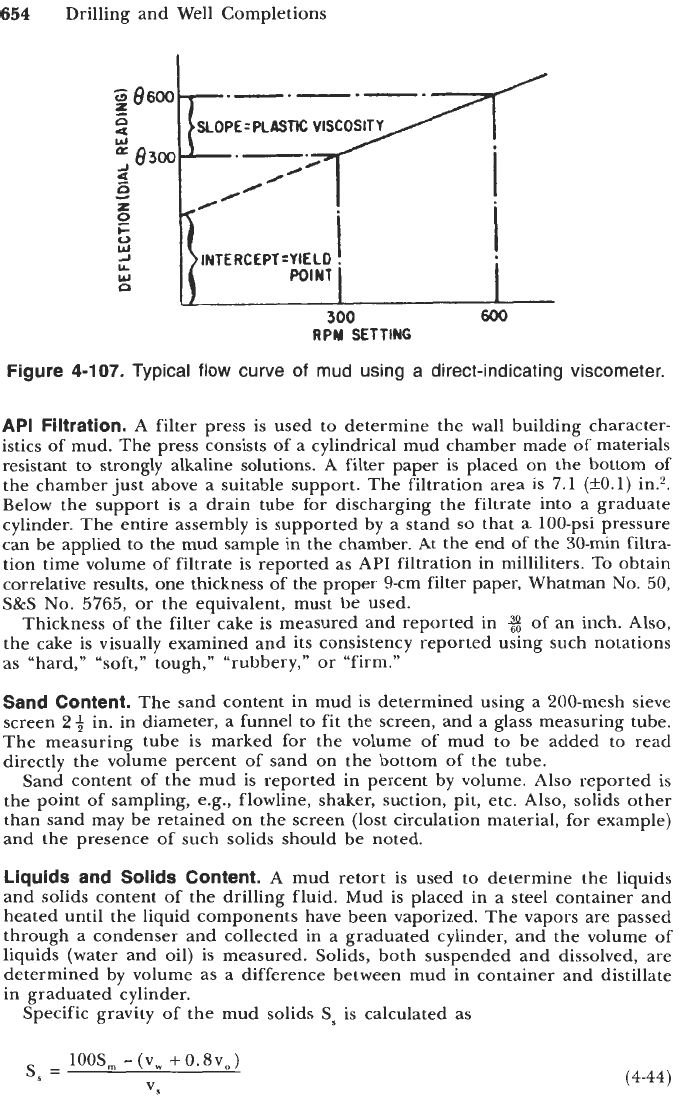
654
Drilling and Well Completions
RPM
SETTING
Figure
4-107.
Typical
flow
curve
of
mud using a direct-indicating viscometer.
API
Filtration.
A
filter press is used to determine the wall building character-
istics of mud. The press consists of a cylindrical mud chamber made of materials
resistant to strongly alkaline solutions.
A
filter paper is placed on the bottom of
the chamber just above a suitable support. The filtration area is
7.1
(fO.l)
in.2.
Below the support is a drain tube for discharging the filtrate into a graduate
cylinder. The entire assembly is supported by a stand
so
that
a
100-psi pressure
can
be applied to the mud sample in the chamber. At the end of the 30-min filtra-
tion time volume of filtrate is reported as
API
filtration in milliliters. To obtain
correlative results, one thickness of the proper 9-cm filter paper, Whatman
No.
50,
S&S
No.
5765,
or
the equivalent, must be used.
Thickness of the filter cake is measured and reported in
t
of
an inch. Also,
the cake is visually examined and its consistency reported using such notations
as “hard,” “soft,” tough,” “rubbery,” or “firm.”
Sand Content.
The sand content in mud is determined using a ZOO-mesh sieve
screen
24
in. in diameter, a funnel to fit the screen, and a glass measuring tube.
The measuring tube is marked for the volume of mud to be added to read
directly the volume percent of sand on the bottom of the tube.
Sand content of the mud is reported in percent by volume. Also reported is
the point of sampling, e.g., flowline, shaker, suction, pit, etc. Also, solids other
than sand may be retained on the screen (lost circulation material, for example)
and the presence of such solids should be noted.
Liquids
and Solids Content.
A
mud retort is used to determine the liquids
and solids content of the drilling fluid. Mud is placed in a steel container and
heated until the liquid components have been vaporized. The vapors are passed
through a condenser and collected in a graduated cylinder, and the volume
of
liquids (water and oil) is measured. Solids, both suspended and dissolved, are
determined by volume as a difference between mud in container and distillate
in graduated cylinder.
Specific gravity of the mud solids
Ss
is calculated as
lOOS,
-(vw
+O.~V,,)
vs
s,
=
(4-44)
